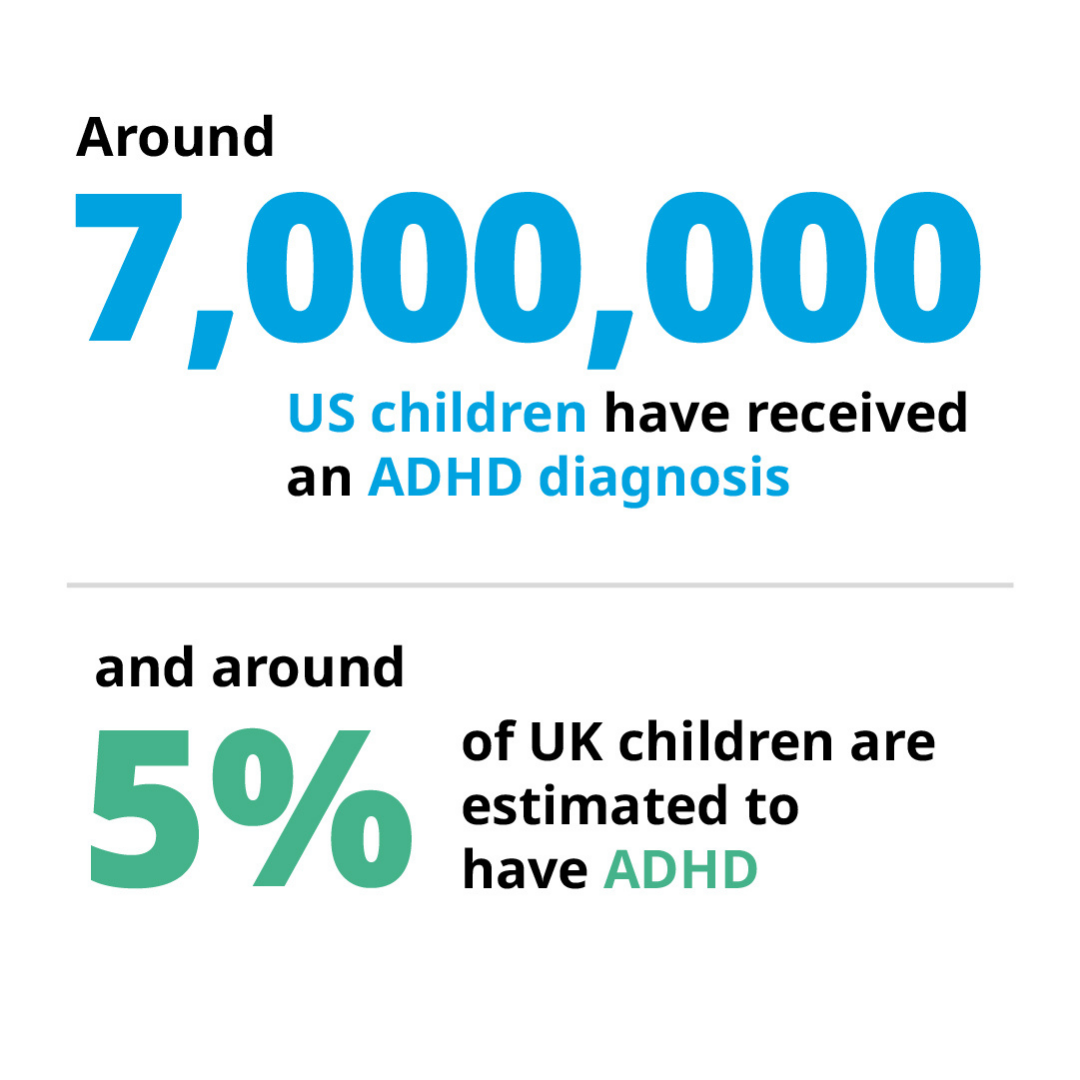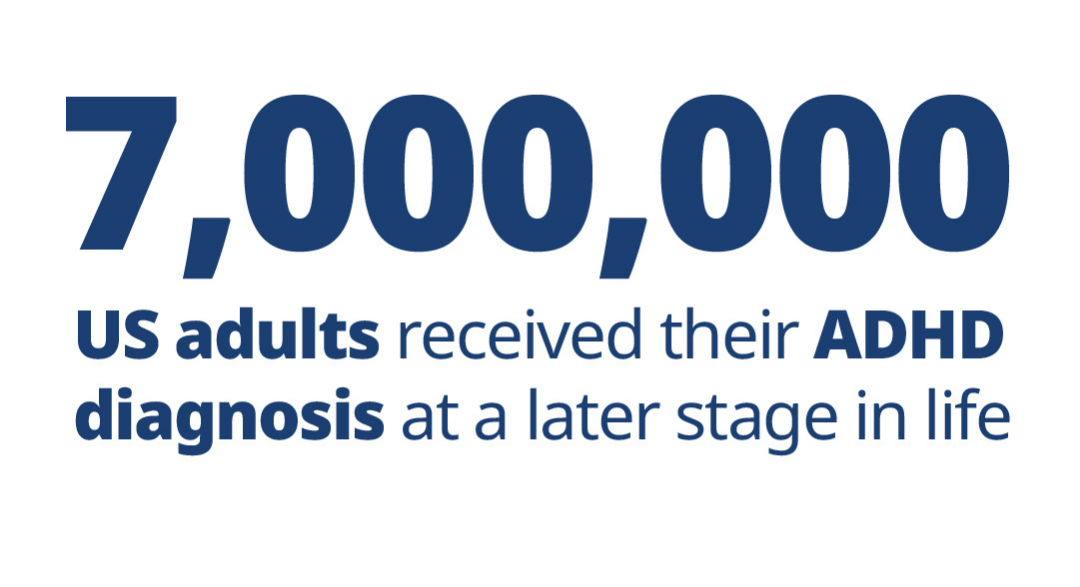ADHD is a diverse and lifelong condition that affects people of all ages, genders, and races. Everyone’s experiences are unique, and symptoms differ from person to person; however, there are trends in how ADHD may present at different life stages.
During ADHD Awareness Month, we’re highlighting the many faces of ADHD. Let’s deep dive into what ADHD looks like at different ages.
ADHD across ages: ADHD is a lifelong neurodevelopmental condition with symptoms that change in intensity and type, from childhood through adulthood.
What does ADHD look like in childhood?
Symptoms and evaluation for ADHD in children vary by age. Hyperactivity and impulsivity may be more common in younger children and may present as excessive talking or interrupting, constant restlessness and fidgeting, and difficulty waiting patiently.
Symptoms of inattention become more prominent in late childhood, when academic and social pressures increase.

Source: Journal of Clinical Child & Adolescent Psychology. NHS England
How does ADHD present in adolescents?
During adolescence, some individuals may find that hyperactivity-impulsivity symptoms improve while symptoms of inattention become more persistent. Clinicians can diagnose people with ADHD for the first time during adolescence due to the increased visibility of inattention symptoms.
Comorbidities are high among adolescents with ADHD. A sample of adolescents with ADHD found that 69.5% had at least one comorbid condition, such as anxiety, depression, and substance use disorder.
What does ADHD look like in adults?
Adults living with ADHD may have been diagnosed as children. However, many people are diagnosed with ADHD for the first time as adults. By late 2023, 15.5 million US adults had received an ADHD diagnosis, with approximately 50% of these being made in adulthood. In the UK, estimates for adult ADHD are around 3-4% of the population.
According to the DSM-5, valid ADHD diagnoses for adults require symptoms to be present before the age of 12 years. This means adults may have developed strong coping or masking mechanisms as a result of living with undiagnosed ADHD for so long. Comorbidities are common for adults with ADHD, with substance use disorders, mood disorders, anxiety, and personality disorders being the most frequent.
Explore patient psychoeducation at different stages
We’ve developed a psychoeducation pack for clinicians to share with patients. The pack examines experiences of ADHD at different life stages and the conversations that may come up in the clinic between parents, children, teens, and adults with ADHD and their clinician.
How external environments affect ADHD presentation
An important element in understanding the many faces of ADHD is how ADHD symptoms can appear differently, not just at different ages, but based on demographic and environmental factors, too.
ADHD and gender – the risk of underdiagnosis of ADHD in females
In childhood, boys are diagnosed with ADHD at around twice the rate of girls. However, by adulthood, rates of diagnosis are much closer to equal. Differences in how symptoms present are a major factor.
Women and girls can present as more inattentive, compared to boys and men who may display more outwardly visible hyperactive-impulsive symptoms. As a result, women and girls are often diagnosed later in life, with a mean age at diagnosis ranging from 16.3 to 28.6 years for females, compared to 11.2 to 22.7 years for males.
ADHD and environmental factors – social pressures and life transitions
Just as those new experiences of increased school pressure and entering into more complex social relationships can draw attention to previously missed ADHD in children and adolescents, life changes and transitions can have an impact on diagnosis at any age.
For adults who have been masking ADHD, a period of intense stress or major life changes may make coping strategies less effective and lead to burnout that triggers an investigation into, and possible diagnosis of ADHD.

Source: CDC
Some life transitions can also exacerbate ADHD symptoms. Falling estrogen levels can exacerbate ADHD symptoms in women around the start of menstruation each month. However, a more sustained and significant impact can be seen during perimenopause and menopause, when estrogen and progesterone levels decline and ADHD symptoms become more severe.
Objective testing – a consistent tool for diagnosing ADHD at different ages
Focusing on commonalities is one way of dealing with the many faces of ADHD. Another is to use technology to supplement the data you have on a patient and their symptoms.
Digital ADHD tools like QbCheck can help with assessing and diagnosing ADHD at different ages by providing clinicians with additional data on symptom effects.
- In younger children (over 6), objective data on symptoms can help to distinguish between developmental concerns and ADHD
- NICE diagnostics guidance has highlighted that data from objective tests can be “helpful when assessing people with subtle presentation (common in girls and women)”
- In the example of fluctuating hormone levels (around menstruation cycles) and perimenopause or menopause, digital tests repeated at different times of the month or during different life stages, can show changing impacts of symptoms over time
The importance of continuity in ADHD care
As age and life transitions can affect ADHD symptom presentation, patients must receive a continuous and high standard of care.
Maintaining an accessible, consistent, and high-quality care model is key to ensuring long-term success for any ADHD practice. The team at ADHD 360, for example, were able to offer 56% more assessments compared to the previous year by adopting a virtual care model.
Hybrid and virtual clinics can help patients maintain continuity in ADHD care, even during times of flux. The more flexible appointment options offered by the use of telehealth in these clinics can also help patients to continue care, even during periods of higher stress, where life changes may be exacerbating symptoms, and physically attending a clinic feels harder to do.
The differing presentations of ADHD also reinforce the need for more tailored and personalized models of ADHD care. Part of recognizing the many faces of ADHD is recognizing that people have different ADHD experiences and different ADHD treatment needs.
The gold standard of ADHD care means delivering high-quality care to patients at any age that meets their specific needs and helps them to thrive with ADHD.
Key takeaways
- Symptoms may change with age: Hyperactivity is more common in children, while inattention and coping difficulties emerge in adolescence and adulthood.
- Gender influences diagnosis: Clinicians typically diagnose females and women with ADHD later due to less obvious symptoms.
- Transitions and stress make a difference: Hormonal changes, school or work stress, and major life transitions are likely to uncover previously unnoticed ADHD symptoms.
- Objective testing technology helps clinicians: Tools like QbCheck provide measurable data to support accurate ADHD diagnosis across the lifespan of patients.
- Continuity of care is crucial: Flexible and consistent models of care allow clinicians to deliver personalized support throughout the patient's ADHD journey.
